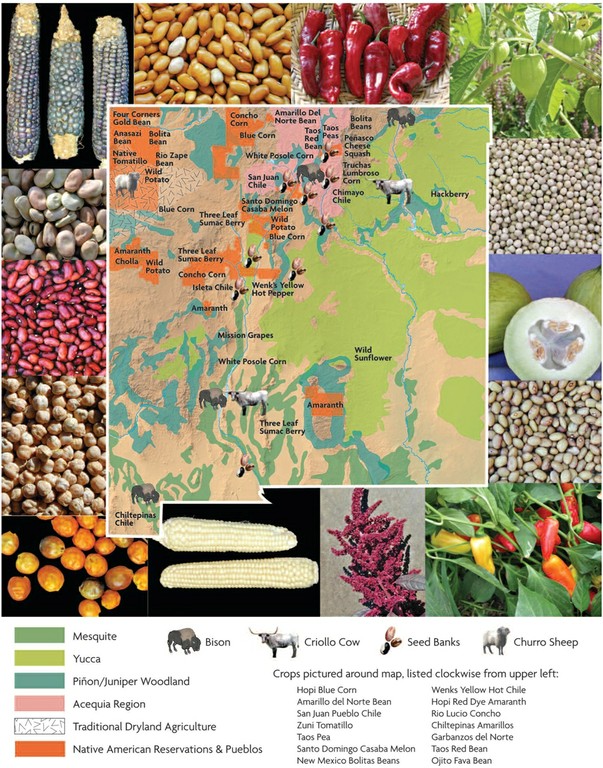All the traditional seeds are like brothers and sisters. It was mostly the women who kept the seeds. My mother would tell me she had to trade seeds with my ‘Tia’ in Ohkay Owingeh because every five years we have to keep rotating the seeds to invigorate them with other seed sources from the different waters: Rio Embudo, Rio Grande, Rio Santa Cruz, Rio Chama.”
— Estevan Arrellano, New Mexico Historian from Embudo.
Saving Traditional Food, Farms and Beauty
In the long arc of New Mexico history, local and invading cultures swapped crops and livestock. Traditional meat supplies — elk, bison, deer and smaller game — expanded with the addition of Spanish semi-wild criollo cattle, domesticated churro sheep and goats, and now Angus, Herefords and Holsteins. To the gathering of mesquite beans, acorns, agave, wild greens, wild potatoes and piñon nuts, Native American first added the Three Sisters (beans, corn and squash), then chiles and then European and Asian crops. Many traditional foods are still gathered and hunted. Juniper ash, for instance, still a crucial ingredient in piki bread, was once mixed with deer brain, then horse fat, before today’s commercial vegetable oils.
Traditional farmers, hunters, gatherers and livestock raisers carry important ethics about land, water and people. Please listen to their voices on the videos.
The Center of Southwest Culture produced a detailed report, Hispano and Native American Farmers in New Mexico for Dreaming New Mexico. More details on biocrops of New Mexico and growing biocultural crops (see 50 crops with images), on the influence of world trade on local cultures (fair trade), on the impacts of fast food (healthy food), and the need to protect water and land to protect New Mexico’s historical legacy (water, saving farms) go to other parts of this web site. New Mexico has declared a Traditional Food and Farming Day to celebrate its agrifood legacies and passed a State Memorial to encourage their preservation.
Map: Biocultural Legacies

Download Biocultural Legacies Map
Background map colors show crops that were traditionally gathered: mesquite beans for flour, yucca fruits, pine nuts and juniper for piki among other uses. The acequia region shows area of highest concentration of acequias (not all). The hatched marks show traditional dryland farming areas of the Colorado Plateau.
Seed banks are organizations that are trying to maintain traditional cultivars. Bison, elk, deer, javelina and water fowl persist in biocultural diets.
